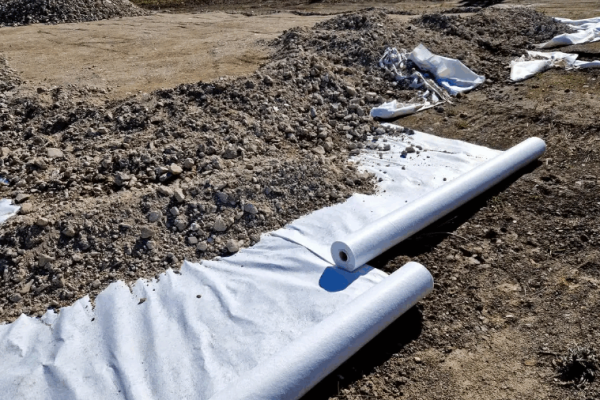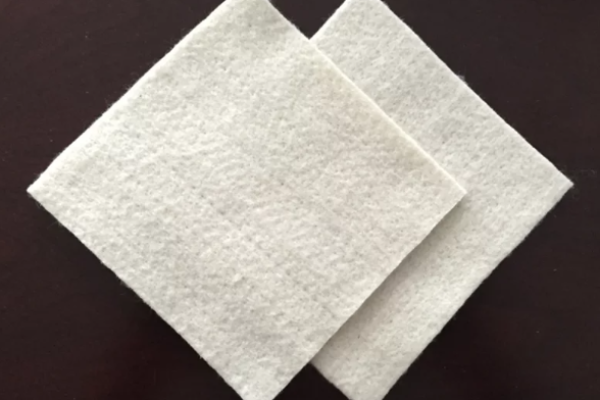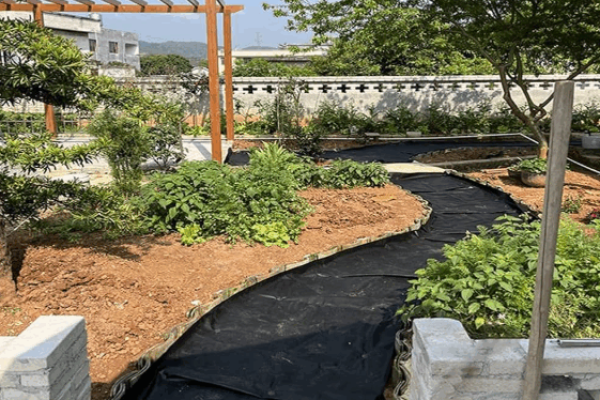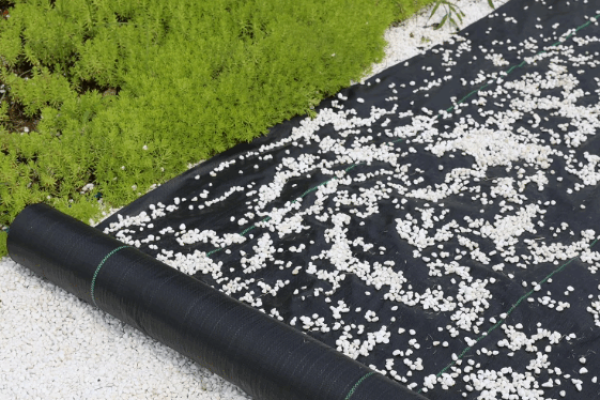- Why is a Geotextile under Riprap Essential?
- What Kind of Fabric do you put under Riprap?
- How to Select the Correct Geotextile for Your Riprap Application
- Installation Guide for Geotextile Under Riprap
- Application Scenarios for Geotextile Under Riprap
- Frequently Asked Questions about Geotextile under Riprap(FAQ)
- Conclusion
When constructing slope protection,reinforcing riverbanks,or building drainage channels,using riprap(rock armour)alone carries significant risks of failure.Issues like soil erosion,sinking stones,and structural collapse often occur due to the absence of a geotextile under the riprap layer.This article systematically explains the principles,selection,applications,and installation of the geotextile fabric used beneath riprap.

Why is a Geotextile under Riprap Essential?
For long-term stability,a riprap structure relies on three core functions provided by the geotextile installed under riprap:
1.Separation Function
Imagine placing large rocks directly on soft mud:heavy machinery and water flow will force the stones to sink into the subsoil,causing an uneven surface and eventual failure.The geotextile for riprap acts as a robust”separator layer,”effectively preventing the intermixing of the upper riprap and the lower subsoil,maintaining the structural integrity of each.
2.Filtration Function
This is the most critical role of the geotextile under rock layers.When water pressure changes,water attempts to flow from the subsoil into the riprap layer.Without a geotextile,fine soil particles are washed away(a process called’piping’),leading to a scoured foundation and subsequent settlement and collapse of the riprap.The geotextile fabric acts as an”intelligent filter,”allowing water to pass through freely while effectively blocking soil particle loss,thus stabilizing the foundation.
3.Reinforcement Function
High-quality geotextile material possesses significant tensile strength.When laid on soft ground,it can distribute loads through friction,enhancing the overall structure’s bearing capacity.It essentially provides an additional reinforcement mesh for the foundation,further improving stability.
Summary:Through separation,filtration,and reinforcement,the geotextile beneath riprap forms a complete protective system,crucial for ensuring the long-term durability of the riprap structure—it is absolutely not optional.
If you are purchasing Geotextile Under Riprap, you can contact us!

What Kind of Fabric do you put under Riprap?
This is a critical question determining the project’s success.Our answer is clear and definite:
The only recommended professional choice is:Non-Woven Geotextile.
Why Non-Woven?
What is it?This type of geotextile looks like thick felt,made from polypropylene fibers randomly arranged and bonded together through a needle-punching process.
Superior Filtration: Its complex three-dimensional mesh structure perfectly balances”water permeability”and”soil retention,”making it specifically designed for engineering filtration applications like riprap foundation projects.
High Permeability: Water can easily pass through its structure without causing water buildup.
Strong Puncture Resistance: Its soft and flexible nature allows it to conform to ground irregularities and resist punctures from sharp rocks.
Materials to AVOID at All Costs:
❌Landscape Fabric:Designed to prevent weeds,it has very poor water permeability.Using it under riprap is like laying a waterproof sheet,leading to internal water pressure buildup and structural failure.
❌Woven Geotextile Fabric(e.g.,tarp material):Has regular pores that easily clog with silt,rendering it ineffective.Its strength is also typically insufficient.
❌Plastic Sheeting:Completely impermeable;a 100%wrong choice.
❌Household Non-Woven Material:Strength and durability are far below engineering requirements.
In a nutshell:Always use professional non-woven geotextile;any substitute likely means project failure.

How to Select the Correct Geotextile for Your Riprap Application
Once the type is confirmed,the next step is selecting the right specifications.
1.Key Performance Indicators
- Tensile Strength:Measures the geotextile’s ability to resist pulling forces,in kN/m.Higher engineering loads require higher strength.
- Puncture Resistance:Crucial for riprap applications!Measures resistance to penetration by sharp stones,in Newtons(N).Select products with a high rating.
- Apparent Opening Size(AOS/O95):The indicator controlling filtration precision,in mm or U.S.Sieve size.For fine sandy subsoils,a smaller AOS(e.g.,O95<0.15mm)is needed to prevent soil loss.
- Permittivity:Measures the water flow capacity.Higher values indicate better drainage performance.
2.Weight and Thickness Guidelines
Common engineering-grade geotextile weights range from 4 oz/yd²(approx.135 g/m²)to 16 oz/yd²(approx.540 g/m²).For small to medium riprap projects,6-8 oz/yd²is often a good starting point.However,for large or critical projects,always consult an engineer and follow specific design specifications.
Installation Guide for Geotextile Under Riprap
Correct installation is as important as material selection.
Step 1:Site Preparation
Remove all vegetation,roots,and sharp objects.
Grade and compact the subgrade to the design slope,ensuring proper drainage.
Step 2:Laying the Geotextile
Direction:Lay the geotextile roll down the slope from top to bottom.
Overlap:The side overlap between adjacent rolls is typically 12-18 inches(approx.30-45 cm).On slopes,ensure the upstream roll overlaps the downstream roll.
Anchoring:Immediately use geotextile stakes/U-pins for temporary anchoring,especially on slopes,to prevent shifting or wind uplift.
Step 3:Placing the Riprap
Critical Warning:Avoid heavy equipment driving directly on the exposed geotextile fabric.A thin layer of sand or soil can be used as a protective transition layer.
Sequence:Start placing rocks from the toe of the slope,working upwards.
Method:Place rocks gently whenever possible;avoid dropping them from height to prevent puncturing or tearing the geotextile under the rocks.
Step 4:Final Inspection&Adjustment
During riprap placement,continually check for tears or displacement.Repair if necessary using geotextile patches.

Common Mistakes and How to Avoid Them
Mistake:Using landscape fabric or plastic sheeting as substitutes.
Avoidance:Insist on professional non-woven geotextile.
Mistake:Installing the geotextile too tight or too loose,with excessive wrinkles.
Avoidance:Lay it flat and snug,allowing slight natural wrinkles for soil settlement but avoiding tautness.
Mistake:Insufficient overlap width.
Avoidance:Strictly adhere to the minimum required overlap width specified in the design.
Mistake:Prolonged UV exposure of the geotextile before covering.
Avoidance:Polypropylene geotextile degrades under UV light.Cover with riprap as soon as possible,ideally on the same day.
Mistake:Using undersized or overly rounded stones for riprap.
Avoidance:Select well-graded,angular stones that interlock to form a more stable matrix.
Application Scenarios for Geotextile Under Riprap
- Riverbank and Coastline Erosion Protection
- Lining for Drainage Ditches and Spillways
- Slope Protection for Highways and Embankments
- Scour Protection around Bridge Piers and Culvert Inlets/Outlets

Frequently Asked Questions about Geotextile under Riprap(FAQ)
Q:What is the lifespan of the geotextile under riprap?
A:Modern polypropylene geotextile is chemically very stable when buried and protected from direct UV exposure.Its design life can extend for decades,even over a century.
Q:How to install on an existing soil slope?
A:First,remove all unstable soil and vegetation from the slope face.Regrade to a stable profile before following the installation steps outlined above.
Q:Does the geotextile require maintenance?
A:Once correctly installed and covered,the geotextile itself requires virtually no maintenance.Focus shifts to periodic inspection of the overlying riprap structure for integrity.
Conclusion
Installing a professional geotextile under riprap is a highly cost-effective step,proven necessary by countless engineering practices.It acts as a silent guardian,ensuring your project withstands the test of time and nature through separation,filtration,and reinforcement.Remember,success hinges on using the correct materials combined with correct installation practices.
If you are looking for a reliable Geotextile Under Riprap supplier,please feel free to contact us.
About Us:Lianjie
Lianjie is a one-stop supplier of geosynthetics with 15 years of professional experience and multiple national certifications.We provide the most professional Geotextile Under Riprap solutions!
Reference Sources
- ASTM D4439 – Standard Terminology for Geosynthetics: Provides unified definitions for all terminology related to geotextiles, geomeMembranes, etc. It is fundamental for understanding professional vocabulary.
- ASTM D4751 – Standard Test Method for Determining Apparent Opening Size (AOS) of a Geotextile: Standardizes how to measure and define AOS, a key indicator of a geotextile’s filtration performance.
- ASTM D4632 – Standard Test Method for Grab Breaking Force and Elongation of Geotextiles: Defines the standard method for testing the tensile strength of geotextiles.
- ASTM D6241 – Standard Test Method for Static Puncture Strength of Geotextiles and Geotextile-Related Products: Standardizes the test for a geotextile’s resistance to puncture by sharp objects (e.g., rocks).
- Source: Available for purchase on the ASTM website (www.astm.org) or via institutional databases like university libraries.















